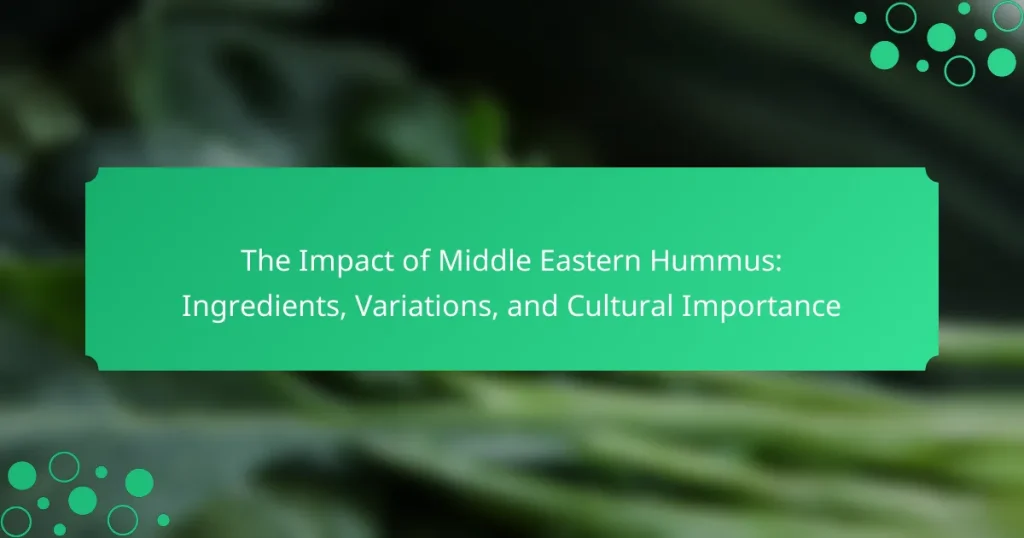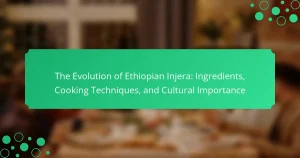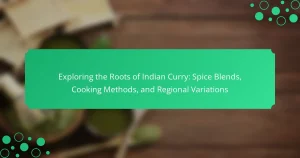Middle Eastern hummus is a traditional dip made from blended chickpeas, tahini, olive oil, lemon juice, garlic, and salt. This dish serves as a staple in Middle Eastern cuisine, with origins tracing back to the 13th century in the Levant region. Hummus is typically enjoyed with pita bread or fresh vegetables and is recognized for its nutritional benefits, including protein, fiber, and healthy fats. The article explores the various ingredients and regional variations of hummus, as well as its cultural significance, particularly in terms of hospitality and community. Additionally, it highlights the global popularity of hummus and its incorporation into diverse diets.

What is Middle Eastern Hummus?
Middle Eastern hummus is a traditional dip made primarily from blended chickpeas. It is typically mixed with tahini, olive oil, lemon juice, garlic, and salt. This dish is a staple in Middle Eastern cuisine. Hummus has ancient origins, dating back to the 13th century in the Levant region. It is often served with pita bread or fresh vegetables. The nutritional profile includes protein, fiber, and healthy fats. Hummus is enjoyed in various cultural contexts, symbolizing hospitality and community. Its popularity has spread globally, making it a common item in many diets today.
How is Middle Eastern Hummus traditionally made?
Middle Eastern hummus is traditionally made by blending cooked chickpeas with tahini, olive oil, lemon juice, and garlic. First, dried chickpeas are soaked overnight and then boiled until soft. Once cooked, they are drained and combined with tahini, a paste made from sesame seeds. Fresh lemon juice is added for acidity, along with garlic for flavor. The mixture is then blended until smooth, with olive oil incorporated to enhance creaminess. Water may be added to achieve the desired consistency. Finally, the hummus is seasoned with salt and garnished with olive oil or spices before serving. This method has been passed down through generations, reflecting the culinary traditions of the Middle East.
What are the key ingredients in traditional hummus?
The key ingredients in traditional hummus are chickpeas, tahini, olive oil, lemon juice, garlic, and salt. Chickpeas serve as the primary base for hummus. Tahini, a paste made from sesame seeds, adds creaminess and flavor. Olive oil enhances the texture and richness. Lemon juice provides acidity and brightness. Garlic contributes a distinctive taste. Salt is used to enhance all the flavors. These ingredients are blended together to create a smooth and flavorful dip.
How do preparation methods vary across regions?
Preparation methods for hummus vary significantly across regions. In the Levant, traditional methods involve using a mortar and pestle to achieve a creamy texture. In Turkey, hummus is often prepared with the addition of yogurt, giving it a distinct flavor. In Israel, variations may include toppings like pine nuts or paprika, enhancing presentation and taste. In contrast, some Western adaptations use blenders for quicker preparation, impacting texture. Regional ingredients also play a role; for example, some areas may incorporate spices like cumin or herbs like parsley. These variations reflect local tastes and cultural influences, showcasing the diversity of hummus preparation.
What variations of Middle Eastern Hummus exist?
Traditional Middle Eastern hummus has several variations. Common types include classic hummus, which is made from chickpeas, tahini, lemon juice, and garlic. Other variations feature added ingredients such as roasted red peppers, which create a smoky flavor. Spicy hummus incorporates ingredients like harissa or chili for heat. Beet hummus adds a vibrant color and earthy taste. Avocado hummus combines creaminess with a unique flavor profile. Each variation maintains the foundational chickpea base while introducing distinct attributes. These adaptations reflect regional preferences and ingredient availability across the Middle East.
What are some popular regional variations of hummus?
Popular regional variations of hummus include Lebanese, Israeli, and Palestinian styles. Lebanese hummus is often creamier and includes additional ingredients like tahini and lemon juice. Israeli hummus may feature toppings such as olive oil, pine nuts, or spicy peppers. Palestinian hummus is known for its unique blend of spices and often has a thicker consistency. Each variation reflects local culinary traditions and preferences, showcasing the versatility of hummus across cultures.
How do additional ingredients transform traditional hummus recipes?
Additional ingredients significantly transform traditional hummus recipes by altering flavor profiles and nutritional content. For instance, adding roasted red peppers enhances sweetness and depth, while garlic introduces a pungent kick. Incorporating spices like cumin or paprika adds warmth and complexity. Ingredients such as tahini provide creaminess and healthy fats, enriching the overall texture. Variations with herbs, like parsley or cilantro, introduce freshness and vibrant color. Each new ingredient can also influence the hummus’s health benefits, increasing fiber or protein content. Studies show that diverse ingredients can appeal to a wider audience, enhancing cultural appreciation and culinary creativity.
What is the cultural significance of Middle Eastern Hummus?
Middle Eastern hummus holds significant cultural importance as a staple dish in the region. It represents communal dining and hospitality. Hummus is often served during gatherings and celebrations, symbolizing unity and sharing. The dish is made primarily from chickpeas, which are a traditional Middle Eastern crop. Its preparation varies across countries, reflecting local customs and flavors. Hummus has been consumed for centuries, with historical references dating back to ancient civilizations. It is also a source of pride, with countries competing for the title of the best hummus. The dish transcends cultural boundaries, becoming popular worldwide while maintaining its Middle Eastern roots.
How is hummus perceived in Middle Eastern cuisine and culture?
Hummus is perceived as a staple food in Middle Eastern cuisine and culture. It is a traditional dish made from blended chickpeas, tahini, olive oil, lemon juice, and garlic. Hummus is often served as an appetizer or side dish. It holds significant cultural importance, symbolizing hospitality and communal eating. Many families prepare hummus at home, passing down recipes through generations. In various Middle Eastern countries, hummus is associated with national identity. For example, Lebanon, Israel, and Palestine each claim unique variations of hummus. The dish is widely enjoyed across the region, often accompanied by pita bread or vegetables. Hummus also features prominently in festive and social gatherings, reinforcing its role in cultural practices.
What role does hummus play in social and communal gatherings?
Hummus serves as a central dish in social and communal gatherings. It promotes sharing and togetherness among participants. Traditionally, it is served with pita bread, encouraging communal dipping. This practice fosters interaction and connection among guests. Hummus is often accompanied by various toppings, enhancing its appeal. It caters to diverse dietary preferences, making it inclusive for all guests. Additionally, its preparation can involve family and friends, strengthening bonds. Cultural significance is evident as hummus represents hospitality in Middle Eastern traditions.
How does Middle Eastern Hummus impact health and nutrition?
Middle Eastern hummus positively impacts health and nutrition. It is rich in plant-based protein, providing essential amino acids. Hummus contains dietary fiber, which aids in digestion and promotes satiety. The chickpeas in hummus are low in glycemic index, helping to regulate blood sugar levels. Healthy fats from tahini contribute to heart health by improving cholesterol levels. Additionally, hummus is packed with vitamins and minerals, including folate, iron, and magnesium. Studies suggest that regular consumption of hummus can support weight management and reduce the risk of chronic diseases. The Mediterranean diet, which includes hummus, is associated with longevity and overall health benefits.
What nutritional benefits does hummus provide?
Hummus provides several nutritional benefits. It is rich in plant-based protein, offering approximately 8 grams per 100 grams. Hummus contains healthy fats, primarily from tahini, which is made from sesame seeds. These fats are beneficial for heart health. Additionally, hummus is high in dietary fiber, contributing to digestive health, with about 6 grams per 100 grams.
The chickpeas in hummus are a good source of vitamins and minerals. They provide iron, magnesium, and folate, which support various bodily functions. Hummus also contains antioxidants, which help combat oxidative stress. The combination of these nutrients makes hummus a nutritious food choice.
How can hummus be incorporated into a balanced diet?
Hummus can be incorporated into a balanced diet as a nutritious dip or spread. It is rich in plant-based protein, fiber, and healthy fats. These attributes contribute to satiety and digestive health. Pairing hummus with fresh vegetables enhances nutrient intake. Whole-grain pita or crackers can serve as healthy vehicles for hummus. This combination provides additional fiber and complex carbohydrates. Studies show that chickpeas, the primary ingredient in hummus, support heart health and weight management. Consuming hummus regularly can improve overall dietary quality.
What are some tips for making the best Middle Eastern Hummus?
Use high-quality ingredients for the best Middle Eastern hummus. Fresh tahini, ripe chickpeas, and extra virgin olive oil enhance flavor. Soak chickpeas overnight for optimal texture. Cook them until tender before blending. Blend the chickpeas with tahini, lemon juice, garlic, and salt. Adjust the consistency with ice-cold water for creaminess. Drizzle olive oil on top and garnish with paprika or parsley. Serve with warm pita bread for the authentic experience.
How can one achieve the perfect texture in hummus?
To achieve the perfect texture in hummus, use high-quality chickpeas and blend them thoroughly. Start with dried chickpeas soaked overnight for optimal creaminess. Cook the chickpeas until very tender to enhance smoothness. Use tahini in the right proportion, typically about one part tahini to two parts chickpeas. Adding ice water gradually while blending helps create a light and airy texture. Blend for a longer duration to ensure a silky consistency. Adjust the amount of lemon juice for flavor without compromising texture. These techniques are supported by culinary experts who emphasize the importance of each ingredient’s quality and preparation.
What are common mistakes to avoid when preparing hummus?
Common mistakes to avoid when preparing hummus include using dry chickpeas instead of canned ones. Canned chickpeas provide a smoother texture and save time. Another mistake is not blending long enough. Proper blending creates a creamy consistency. Adding too much tahini can overpower the flavor. A balanced amount enhances the taste without dominating it. Failing to season adequately with salt and lemon juice can result in bland hummus. Taste testing during preparation helps achieve the right flavor. Skipping the garlic can lead to a lack of depth in flavor. Finally, not using enough olive oil can make the hummus dry. A drizzle of high-quality olive oil adds richness and moisture.
Middle Eastern hummus is a traditional dip made primarily from blended chickpeas, tahini, olive oil, lemon juice, garlic, and salt, with a rich history dating back to the 13th century. This article explores the key ingredients and preparation methods of hummus, highlighting regional variations and their cultural significance within Middle Eastern cuisine. It also examines the nutritional benefits of hummus and offers tips for achieving the perfect texture while avoiding common preparation mistakes. The discussion emphasizes hummus’s role in social gatherings and its impact on health, showcasing its importance as both a culinary and cultural staple.




